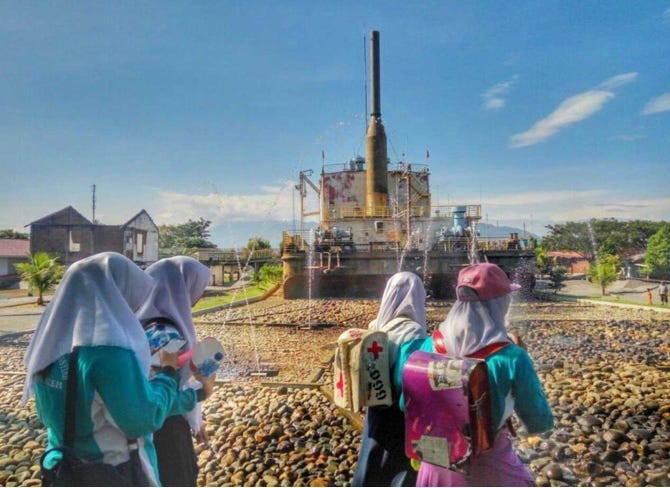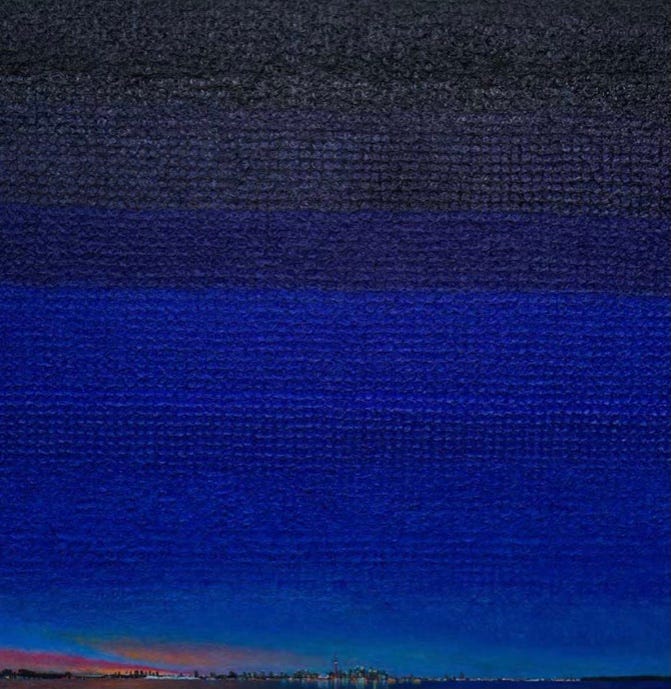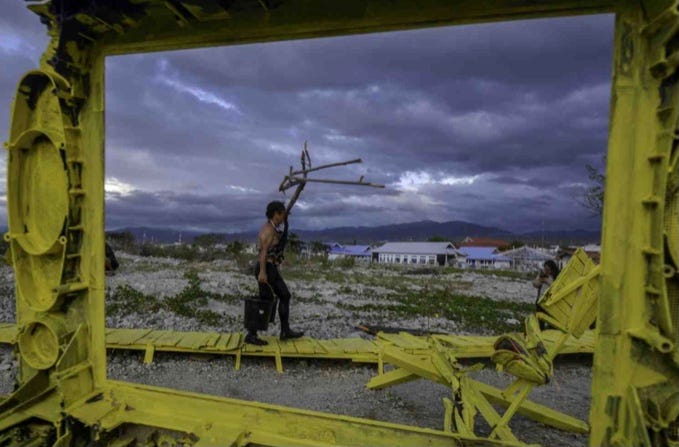The Art of Self-Examination
Chatting with Tarantula's artist of November, the interdisciplinary artist Daisuke Takeya
Standing in front of the portfolio of the multi-faceted Japanese Canadian artist, Daisuke Takeya, be it a shrine to tsunami of a human scale or the endless sky, humbly puts the human race into its place by scaling us down to our actual size on planet Earth. The minimal impact of our own lives becomes apparent in his art pieces that question why are we here? Why are these events and situations happening to us. Are they happening to us? It is precisely this cross-examination that stimulates Daisuke’s childlike curiosity to begin to play and explore. And just the same as when you give a child some material and paints, the end result is hard to predict, but you know that you are in for a surprise.
While many artists deepen one theme or method during their whole careers, the medium, tools and themes that Daisuke uses develop organically in an attempt to best serve whichever question is up for analysis. Thus, always starting from the beginning, this artist has lived through many of his own reincarnations.
Accordingly, when the Great East Japan Earthquake and Tsunami in 2011 happened, Daisuke Takeya accepted the call for action. Instead of agonizing in front of the devastated images of the event that were on repeat on his TV screen, like a real chameleon he changed his colors again and rebirthed a new type of artist - Daisuke Takeya as a performing artist/activist. It was time to bring together all of his lessons and influences, Japanese pop, Japanese poetry, films, abstract art, etc., to the table and to utilize art in a humanitarian way in order to help the long term recovery of the affected communities, especially the youngest witnesses. At the same time, he started performing directly with nature, daring it, challenging it and painting over it as well as over the post-tsunami debris that he found scattered on Asian beaches as an offer of his love and appreciation.
After all, it was time to roll up one’s sleeves and act as an agent and not just a student of life. It was time to rebuild trust and reexamine the relationship between humans and Mother Earth again. Consequently, Daisuke Takeya’s art expanded beyond the self that was always observing on the sides and instead stepped into the center of life’s creation with a purpose to contribute to matters bigger than just the final product.

Tarantula Authors and Art caught up with Daisuke as he embarks on yet a new adventure on a farm in the city of Ishinomaki in Japan where he is bringing to life a community hub.
Tarantula: Look up, what’s up, Daisuke?
Daisuke: Bright starry sky.
What does the word “water” mean to you?
Water to me means a symbol of circulations and transformations. We all need it and within us, as well as outside of us it is constantly changing its form while remaining connected with us all.
For someone who follows your art from the beginning of your career, it’s noticeable that the Great East Japan Earthquake and Tsunami of 2011 affected your work and in some way took you out of your private world of imagination and put you in the middle of the collective; it took you from making oil paintings to performance art. Can you tell us a bit about that process?
I guess that this would be quite difficult, as I am still in the process of evolving. It is very true that the disaster affected me to do more Socially Engaged Art, responding to critical issues in both global and regional terms. Additionally, I have expanded my praxis to different disciplines, and I have met with interesting people from different fields, hence 3C’s (Consciousness, Collective Intelligence, and Co-Existence) seems to be the must for any critical thinkers of our time.
Can you explain a bit more how you use the 3 C’s in your process of creating?
20th Century is 3M’s, which is Money, Material and Men. 21st Century is 3C’s. Not sure how this will change after the pandemic though.
At the time of this interview you find yourself in the countryside of Japan renovating a farm. Can you tell us what’s going on? Did you move back to Japan for good?
I have been leading a transnational traveling art projects entitled Field Trip Project and Field Trip Project Asia for the last 10 years since the Great East Japan Earthquake and Tsunami. Now that the project is moving forward to the next phase, the farm will be transformed into my studio space, an artist residence as well as a community hub, in addition to becoming a resource/archive museum for the Field Trip Project. I think it is appropriate as it is in the city of Ishinomaki, in the Miyagi prefecture which was one of the most devastated at the time of tsunami.

How is the situation now? Are people welcoming to your idea of turning the farm into a cultural center? Do you think that people like to be reminded of what happened or would they like to forget it?
Perhaps every individual feels about the situation differently. As per my neighbours, they like the idea of a hub to be erected in the area where depopulation is in progress. However, it is not desired to become a cultural center, rather semi-private as my house and semi-public as a place where diverse communities intermingle. The locals think that it is important to remember what happened and pass the information to the next generation by disaster folklore, monuments and memorials in the city. My place is nothing like that, but it will consist of different functions and one of them will be the project’s archive and not of the disaster.
Our readers who watched your four videos that compose Solitude Standing know that when corona began, you found yourself in Canada? Can you tell us how did this period affect you as a person and as an artist? Is that why you moved to a farm now?
When Covid hit Toronto, Canada, I have already been in my “productive zoning” of painting for my upcoming exhibitions. Hence, the lockdowns and other social restrictions did not affect me as much comparing to my friends in other industries. Yet, people are so physically isolated, and your private became public via online meetings. I wouldn’t deny that this isolation encouraged me to seek to get out of the city, and move close to a natural environment.

Any thoughts on what do you think the role of an artist is as we transition slowly to a post pandemic world?
Showing new maps, planting seeds, transforming thoughts. These have been the role for the artists pre-pandemic. I think it will stay the same, but the term “artist” may become more diverse and subdivided.
In what way?
The term “artist” is quite diverse now. Everyone is a curator and all musicians are artists, that started even before the pandemic. Many artists affected by the pandemic shifted their ways of working because of their forced circumstances like myself moving to the countryside living with nature. No longer the term “artist” holds us in the same genre as it was traditionally known.
One of our subscribers, Djurdjica, wanted to ask you what inspires you, where do you get your ideas?
Everything interests me. It is only up to you how you see a thing at a particular time from a particular angle under a particular given circumstance. I am not inventing anything, yet reviewing who I am, where I am at, etc., and only trying to understand what they are. I am certain that everyone does that to some extent, and in my case, I use my process of art making and sharing it with my audience in order to understand any given situation.
After musing over your work, the same reader also commented how interesting it is that you start from the beginning every time, be it materials, medium or new themes. This is something that our readers admire but are probably afraid to try themselves. How do you just plunge into something new? Is there fear? Is there something you do to overcome the fear?
I guess I always have fear. Being a struggling artist barely surviving even after over decades long practice, my only fear is that one day I may no longer be able to continue my praxis. All challenges to try something new is nothing fearful comparing to that.
As an interdisciplinary artist, how do you choose which medium and materials are you going to use for a specific project?
I guess it is organically decided each time. Performance art is more immediate and approachable, while painting is more controllable and longer in its production process, etc.
You have so many projects behind you, is there one that is in some way particularly special? Why?
Everything is special. If not special enough, I let someone else take the lead it.

You are someone who lived and worked on different continents and in different countries, does that make you at home everywhere or an immigrant in your country of birth? How does living in these culturally, historically and traditionally different countries affect you as a person and your work and/or inspiration?
Locating myself in different places is a normal thing for me. I am not a nomad, yet I always feel that I am a newcomer, or an emerging artist. I think it is healthy that every artwork is a new challenge, and nothing is repetitive so that I maintain my passion, interests, motivation in high standard.
That is probably why you go into many different directions, you are not known only as a landscape artist, or portrait or performance, or a naturalist. You seem to have never lost that child like curiosity and questioning. What are you working on now?
A few different projects. Will share them on social media.
Ok, a secret. Can you share at least one word to ignite our anticipation?
A curatorial project in Japan in May, another one in the Philippines in June, Participating in an art fair in Europe in April, and so on - all depending on the pandemic.
Can you give our readers an example of how can they include art daily into their lives?
Art is everywhere near you. You only need to look at a thing from a different perspective and notice the difference. Production and viewing of art are the next step.
Can you give an example of how to look at things differently, or a first step to production? (I ask this because most people have no idea how to begin. What would you tell your students when you were an art teacher?)
You walk the same street everyday to go to school or work. You do not notice small things like weeds around. Stop for a few minutes and look for a particular one and give it a name, and think about why you picked that one. Then, come back to it the next day. If you can find that particular weed, you may have a special connection with it, and you probably have some kind of inspirations; you may put something around the weed, put a name tag, write a letter to it, etc. Making ordinary extraordinary is not that of a big deal. Just looking at it differently and spending a minute or two will do.
If our readers wanted to learn more about you and see your work, where can they find you?
Please visit my website.
And at the end, you always greeted with the expression What’s Up, Look Up! Why add “look up?"
Not sure why. But I just want to fight the gravity sometime and challenge my limit…
Nice chatting with you Daisuke! Stay in touch and keep Tarantula: Authors and Art readers updated on your upcoming projects.

Tarantula: Authors and Art was able to showcase just a snippet of Daisuke Takeya’s magical world of art. To find out more about Daisuke and his art visit https://daisuketakeya.com.



